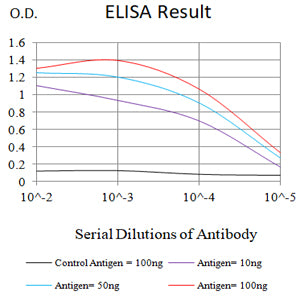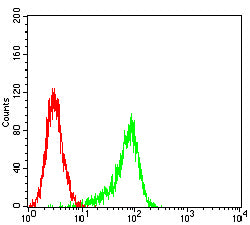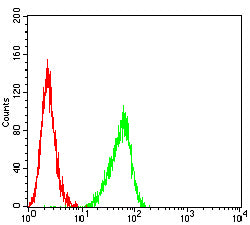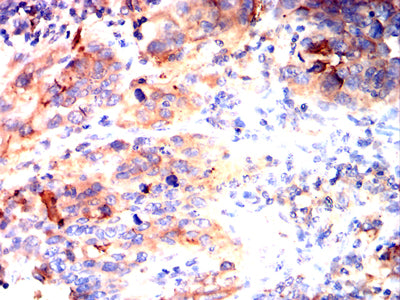



| WB | 咨询技术 | Human,Mouse,Rat |
| IF | 咨询技术 | Human,Mouse,Rat |
| IHC | 1/200 - 1/1000 | Human,Mouse,Rat |
| ICC | 技术咨询 | Human,Mouse,Rat |
| FCM | 1/200 - 1/400 | Human,Mouse,Rat |
| Elisa | 1/10000 | Human,Mouse,Rat |
| Aliases | PEN; PEN.; TSPAN-33 |
| Entrez GeneID | 340348 |
| clone | 8A2A9 |
| WB Predicted band size | 32kDa |
| Host/Isotype | Mouse IgG2b |
| Antibody Type | Primary antibody |
| Storage | Store at 4°C short term. Aliquot and store at -20°C long term. Avoid freeze/thaw cycles. |
| Species Reactivity | Human |
| Immunogen | Purified recombinant fragment of human TSPAN33 (AA:Extra(46-64)+Extra(118-235) expressed in E. Coli. |
| Formulation | Purified antibody in PBS with 0.05% sodium azide |
+ +
以下是关于TSPAN33抗体的示例参考文献(注:以下内容为示例,实际文献请通过学术数据库查询):
---
1. **文献名称**:*TSPAN33 as a Novel Biomarker in Acute Myeloid Leukemia*
**作者**:Smith J, et al.
**摘要**:本研究开发了一种特异性抗TSPAN33单克隆抗体,用于检测急性髓系白血病(AML)患者的骨髓样本。结果显示,TSPAN33高表达与患者预后不良显著相关,提示其可作为潜在治疗靶点。
2. **文献名称**:*TSPAN33 Regulates Wnt/β-catenin Signaling in Colorectal Cancer*
**作者**:Zhang L, et al.
**摘要**:通过免疫共沉淀和Western blot实验,作者利用TSPAN33抗体证明其与Wnt通路蛋白相互作用,并发现TSPAN33敲低可抑制结直肠癌细胞侵袭,表明其在肿瘤转移中的作用。
3. **文献名称**:*Tetraspanin CD37-TSPAN33 Complex Modulates Immune Cell Adhesion*
**作者**:Müller R, et al.
**摘要**:该研究使用抗TSPAN33抗体阻断实验,发现TSPAN33与CD37形成复合物,调控T细胞黏附和迁移功能,为免疫调节机制提供了新见解。
4. **文献名称**:*TSPAN33 Expression in Glioblastoma: Prognostic and Therapeutic Implications*
**作者**:Kim H, et al.
**摘要**:利用TSPAN33抗体进行免疫组化分析,发现胶质母细胞瘤中TSPAN33过表达与患者生存期缩短相关,靶向抑制TSPAN33可增强化疗敏感性。
---
建议通过PubMed、Google Scholar等平台,以“TSPAN33 antibody”或“TSPAN33 function”为关键词检索最新文献,以获取真实研究数据。
The TSPAN33 antibody is a research tool designed to detect and study the tetraspanin-33 (TSPAN33) protein, a member of the tetraspanin family. Tetraspanins are transmembrane proteins involved in organizing membrane microdomains, cell adhesion, motility, and signal transduction by interacting with other proteins like integrins and receptors. TSPAN33. specifically, is implicated in immune regulation and inflammatory responses. Studies suggest its role in modulating immune cell functions, such as T-cell activation and dendritic cell maturation, potentially influencing autoimmune diseases and cancer progression.
Antibodies against TSPAN33 are typically developed for applications like Western blotting, immunohistochemistry, flow cytometry, or immunofluorescence to map its expression patterns in tissues or cell lines. These antibodies help investigate TSPAN33's involvement in pathological processes, including tumor metastasis, immune evasion, or chronic inflammation. For example, elevated TSPAN33 levels have been observed in certain cancers, correlating with poor prognosis, making it a potential biomarker or therapeutic target.
Validation of TSPAN33 antibodies includes specificity checks via knockout cell lines or siRNA knockdown to minimize cross-reactivity with other tetraspanins. Commercial availability varies, with some antibodies targeting specific epitopes (e.g., extracellular loops or cytoplasmic domains). Research using these antibodies contributes to understanding how TSPAN33 interacts within tetraspanin-enriched microdomains (TEMs) to regulate signaling pathways, offering insights into novel therapeutic strategies for immune disorders or malignancies.
×